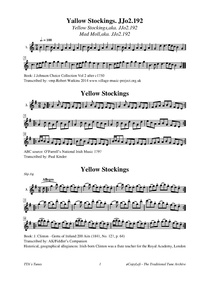Template:Pagina principale/Vetrina: Difference between revisions
No edit summary |
No edit summary |
||
| Line 1: | Line 1: | ||
{{SheetMusic | {{SheetMusic | ||
|f_track= | |f_track=Yellow Stockings.mp3 | ||
|f_pdf= | |f_pdf=Yellow Stocking.pdf | ||
|f_artwork= | |f_artwork=Mollcutpurse.jpg | ||
|f_tune_name= | |f_tune_name=Yellow_Stockings | ||
|f_track_title= | |f_track_title=Yellow_Stockings | ||
|f_section=abc | |f_section=abc | ||
|f_played_by=[https://soundcloud.com/ | |f_played_by=[https://soundcloud.com/fiddlersbidofficial Fiddlers' Bid] | ||
|f_notes= | |f_notes= From Haynes, Alan: Sex in Elizabethan England, page 119. Wrens Park Publishing, 1997 This image was from the title-page of The Roaring Girl. | ||
|f_caption= | |f_caption=The tune dates from the 16th century and is a member of a very large tune family. Henry Playford first printed it in 1698 in his Dancing Master under the title Mad Moll, a dance named for Mary 'Moll' Frith, and amateur actress and professional pickpocket. | ||
|f_source=[https://soundcloud.com/ | |f_source=[https://soundcloud.com/fiddlersbidofficial/yellow-stockings Soundcloud] | ||
|f_pix=420 | |f_pix=420 | ||
|f_picpix=200 | |f_picpix=200 | ||
|f_article=[[ | |f_article=[[Yellow_Stockings | '''Yellow_Stockings''']] | ||
The tune dates from the 16th century and is a member of a very large tune family. Henry Playford first printed it in 1698 in his '''Dancing Master''' (under the title "[[Mad Moll (1)]]", a dance named for Mary "Moll" Frith, and amateur actress and professional pickpocket), and later in his 1703 edition with another dance under the title "[[Virgin Queen]]." | |||
In 1705 Dean Swift adapted a nursery song to it beginning "Here my kitten, my kitten" ("O my Kitten"). The title "Yellow Stockings" for the tune appear in dancing master Daniel Wright's '''North Country Frisks''' (1713) and (as "Yallow Stockings") in his '''Extraordinary Collection of Pleasant and Merry Humour's never before Published, Containing Hornpipes, Jiggs, North Cuntry Frisks', Morris's, Bagpipe Hornpipe's, & Round's with Severall Additonal fancis added. fit for all those that play Publick" (c. 1713, No. 62). John and William Neal printed it in their '''Choice Collection of Country Dances''' (Dublin, 1726). | |||
{{break|2}} | |||
As a vocal melody it can be heard in Charles Coffee’s ballad opera '''Boarding School''' (1733), '''The Cobler of Preston''' (1732), and it was published in a folio of songs from Henry Brooke’s '''Jack the Gyantqueller''' (London, 1749). Thomas Moore used it as the vehicle for his lyric "Fairest Put On Awhile." | |||
Sir John Hawkins mentioned the tune in this quote regarding tavern entertainment from his 1576 '''A General History of the Science and Practice of Music''': | |||
<blockquote> | |||
''...Fidlers and others, hired by the master of the house; such as'' | |||
''in the night season were wont to parade the city and suburbs'' | |||
''under the title of Waits...Half a dozen of fidlers would scrape'' | |||
''"Sellenger's Round", or "John Come Kiss Me", or "Old Simon'' | |||
''the King" with divisions, till themselves and their audience were'' | |||
''tired, after which as many players on the hautboy would in the'' | |||
''most harsh and discordant tones grate forth "Greensleeves,"'' | |||
''"Yellow Stockings," "Gillean of Croydon," or some such common'' | |||
''dance tune, and the people thought it fine music.'' | |||
</blockquote> | |||
}} | }} | ||
Revision as of 10:49, 18 November 2023

Played by: Fiddlers' Bid
Source: Soundcloud
Image: From Haynes, Alan: Sex in Elizabethan England, page 119. Wrens Park Publishing, 1997 This image was from the title-page of The Roaring Girl.

The tune dates from the 16th century and is a member of a very large tune family. Henry Playford first printed it in 1698 in his Dancing Master (under the title "Mad Moll (1)", a dance named for Mary "Moll" Frith, and amateur actress and professional pickpocket), and later in his 1703 edition with another dance under the title "Virgin Queen."
In 1705 Dean Swift adapted a nursery song to it beginning "Here my kitten, my kitten" ("O my Kitten"). The title "Yellow Stockings" for the tune appear in dancing master Daniel Wright's North Country Frisks (1713) and (as "Yallow Stockings") in his Extraordinary Collection of Pleasant and Merry Humour's never before Published, Containing Hornpipes, Jiggs, North Cuntry Frisks', Morris's, Bagpipe Hornpipe's, & Round's with Severall Additonal fancis added. fit for all those that play Publick" (c. 1713, No. 62). John and William Neal printed it in their Choice Collection of Country Dances (Dublin, 1726).
As a vocal melody it can be heard in Charles Coffee’s ballad opera Boarding School (1733), The Cobler of Preston (1732), and it was published in a folio of songs from Henry Brooke’s Jack the Gyantqueller (London, 1749). Thomas Moore used it as the vehicle for his lyric "Fairest Put On Awhile."
Sir John Hawkins mentioned the tune in this quote regarding tavern entertainment from his 1576 A General History of the Science and Practice of Music:
...Fidlers and others, hired by the master of the house; such as in the night season were wont to parade the city and suburbs under the title of Waits...Half a dozen of fidlers would scrape "Sellenger's Round", or "John Come Kiss Me", or "Old Simon the King" with divisions, till themselves and their audience were tired, after which as many players on the hautboy would in the most harsh and discordant tones grate forth "Greensleeves," "Yellow Stockings," "Gillean of Croydon," or some such common dance tune, and the people thought it fine music.
...more at: Yellow_Stockings - full Score(s) and Annotations
X:0 T:Yallow Stockings T:Yellow Stockings M:9/4 L:1/4 Q:3/4=100 S:D.Wright, Extraordinary Collection, London 1713 Z:Pete Stewart, 2004 <www.hornpipemusic.co.uk> K:C V:1 clef=treble name="0." [V:1] B|c>BAAEAAEB|cA/B/cAEABGB|c>BAAEAAEA|B2GG>AGBG|| B|c/B/c/d/eB2AAEA|c/B/c/d/e B2A BGB|c>deB2AAEA|BdgBdgBG|| B|c>dagaA2B|c/B/c/d/egfgG2A|c>de/f/agaA2B|c>de/f/ g2dBG|| B|c/d/c/B/A GEG C2B|cBAGEFG2B|c/d/c/B/AGE/F/GC2c|B2gd>ed/c/BG|| B|cegc/d/e/f/gBGB|cegga/g/f/e/fdB|cegcegBGB|cBAGEGA,2|] % Output from ABC2Win Version 2.1 f on 05/05/2004
